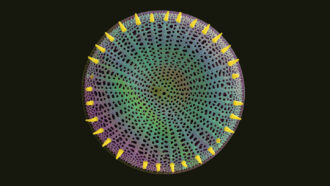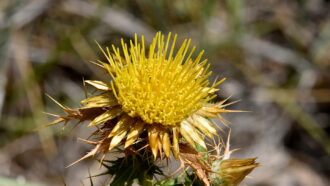algae: Single-celled organisms, once considered plants (they aren’t). As aquatic organisms, they grow in water. Like green plants, they depend on sunlight to make their food.
bacteria: (singular: bacterium) Single-celled organisms. These dwell nearly everywhere on Earth, from the bottom of the sea to inside other living organisms (such as plants and animals). Bacteria are one of the three domains of life on Earth.
biofilm: A gooey community of different types of microbes that essentially glues itself to some solid surface. Living in a biofilm is one way microbes protect themselves from stressful agents (such as poisons) in their environment.
cell: (in biology) The smallest structural and functional unit of an organism. Typically too small to see with the unaided eye, it consists of a watery fluid surrounded by a membrane or wall. Depending on their size, animals are made of anywhere from thousands to trillions of cells. Most organisms, such as yeasts, molds, bacteria and some algae, are composed of only one cell. (in telecommunications) A technology that relies on a large number of base stations to relay signals. Each base station covers only a small area, which is known as a cell. Phones that rely on this system are typically referred to as cell phones.
cellulose: A type of fiber found in plant cell walls. It is formed by chains of glucose molecules.
component: Something that is part of something else (such as pieces that go on an electronic circuit board or ingredients that go into a cookie recipe).
diet: (n.) The foods and liquids ingested by an animal to provide the nutrition it needs to grow and maintain health. Sometimes this is a specific food-intake plan. (v.) To adopt a specific food-intake plan. People may adopt one for religious or ethical reasons, to address food allergies or to control a disease such as high blood pressure or diabetes. They may also adopt one in an effort to lose weight, though this can an unhealthy thing if not done under the guidance of a health professional, such as a physician or registered dietician.
digest: (noun: digestion) To break down food into simple compounds that the body can absorb and use for growth. Some sewage-treatment plants harness microbes to digest — or degrade — wastes so that the breakdown products can be recycled for use elsewhere in the environment.
fabric: Any flexible material that is woven, knitted or can be fused into a sheet by heat.
fiber: Something whose shape resembles a thread or filament. (in nutrition) Components of many fibrous plant-based foods. These so-called non-digestible fibers tend to come from cellulose, lignin, and pectin — all plant constituents that resist breakdown by the body’s digestive enzymes.
filter: (n.) Something that allows some materials to pass through but not others, based on their size or some other feature. (v.) The process of screening some things out on the basis of traits such as size, density, electric charge.
glucose: A simple sugar that is an important energy source in living organisms. As an energy source moving through the bloodstream, it is known as “blood sugar.” It is half of the molecule that makes up table sugar (also known as sucrose).
gut: An informal term for the gastrointestinal tract, especially the intestines.
herbivore: A creature that either exclusively or primarily eats plants.
manufacturing: The making of things, usually on a large scale.
microbe: Short for microorganism. A living thing that is too small to see with the unaided eye, including bacteria, some fungi and many other organisms such as amoebas. Most consist of a single cell.
molecule: An electrically neutral group of atoms that represents the smallest possible amount of a chemical compound. Molecules can be made of single types of atoms or of different types. For example, the oxygen in the air is made of two oxygen atoms (O2), but water is made of two hydrogen atoms and one oxygen atom (H2O).
plastic: Any of a series of materials that are easily deformable; or synthetic materials that have been made from polymers (long strings of some building-block molecule) that tend to be lightweight, inexpensive and resistant to degradation. (adj.) A material that is able to adapt by changing shape or possibly even changing its function.
polymer: A substance made from long chains of repeating groups of atoms. Manufactured polymers include nylon, polyvinyl chloride (better known as PVC) and many types of plastics. Natural polymers include rubber, silk and cellulose (found in plants and used to make paper, for example).
sponge: Something that sops up liquids or other materials and holds them until squeezed out or removed in some other way.









